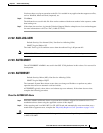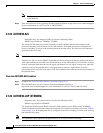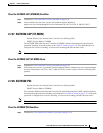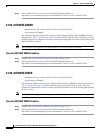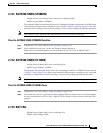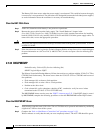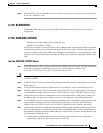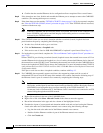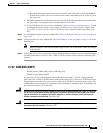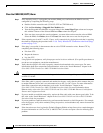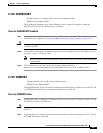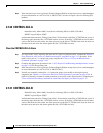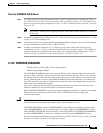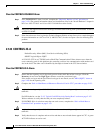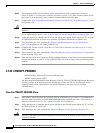
2-35
Cisco ONS 15310-CL and Cisco ONS 15310-MA Troubleshooting Guide, R7.0
Chapter 2 Alarm Troubleshooting
2.7.37 CARLOSS (EQPT)
• Record the information in the type and size columns of the circuit that is part of the Ethernet
manual cross-connect. The cross-connect circuit connects the Ethernet port to an OC-N port at
the same node.
e. Determine whether the two Ethernet circuits on each side of the Ethernet manual cross-connect have
the same circuit size from the circuit size information you recorded.
f. If one of the circuit sizes is incorrect, complete the “Delete a Circuit” procedure on page 2-155 and
reconfigure the circuit with the correct circuit size. Refer to the “Create Circuits” chapter in the
Cisco ONS 15310-CL and Cisco ONS 15310-MA Procedure Guide for detailed procedures to do
this.
Step 13 If a valid Ethernet signal is present, complete the “Remove and Reinsert (Reseat) a Card” procedure on
page 2-154.
Step 14 If the alarm does not clear, complete the “Physically Replace a Card” procedure on page 2-154 for the
Ethernet card.
Note When you replace a card with the identical type of card, you do not need to make any changes
to the database.
Step 15 If the alarm does not clear, log into the Technical Support Website at http://www.cisco.com/techsupport
for more information or call Cisco TAC (1-800-553-2447) in order to report a Service-Affecting (SA)
problem.
2.7.37 CARLOSS (EQPT)
Default Severity: Major (MJ), Service-Affecting (SA)
SONET Logical Object: EQPT
A Carrier Loss on the LAN Equipment alarm generally occurs on OC-3 and OC-12 ports when the
ONS 15310-CL or ONS 15310-MA and the workstation hosting CTC do not have a TCP/IP connection.
The problem involves the LAN or data circuit used by the LAN (RJ-45) connector on the system. The
CARLOSS alarm does not involve an Ethernet circuit connected to an Ethernet port. The problem is in
the connection and not CTC or the node.
Warning
Invisible laser radiation could be emitted from the end of the unterminated fiber cable or connector.
Do not stare into the beam directly with optical instruments. Viewing the laser output with certain
optical instruments (for example, eye loupes, magnifiers, and microscopes) within a distance of
100 mm could pose an eye hazard.
Statement 1056
Warning
Use of controls, adjustments, or performing procedures other than those specified could result in
hazardous radiation exposure.
Statement 1057



